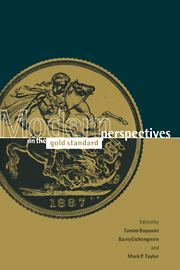Book contents
- Frontmatter
- Contents
- List of figures
- List of tables
- Notes on the contributors
- I Introduction
- II Operation of the gold standard
- III Adjustment mechanisms
- 6 The stability of the gold standard and the evolution of the international monetary fund system
- 7 International adjustments under the Classical gold standard: evidence for the United States and Britain, 1879–1914
- 8 Balance of payments adjustment under the gold standard policies: Canada and Australia compared
- IV Monetary issues
- V Exchange rate behavior
- VI Conclusions
- Index
8 - Balance of payments adjustment under the gold standard policies: Canada and Australia compared
Published online by Cambridge University Press: 05 November 2011
- Frontmatter
- Contents
- List of figures
- List of tables
- Notes on the contributors
- I Introduction
- II Operation of the gold standard
- III Adjustment mechanisms
- 6 The stability of the gold standard and the evolution of the international monetary fund system
- 7 International adjustments under the Classical gold standard: evidence for the United States and Britain, 1879–1914
- 8 Balance of payments adjustment under the gold standard policies: Canada and Australia compared
- IV Monetary issues
- V Exchange rate behavior
- VI Conclusions
- Index
Summary
Introduction
The operation of the Classical gold standard has recently received renewed attention by scholars as a potential source of arguments for and against a commodity standard and of clues to the propriety of fixed versus flexible exchange rates. History has not provided a widespread monetary experiment of this kind since the gold standard effectively ended with the onslaught of World War I. The gold standard era also provides a history of shocks that permit us to explore a full range of scenarios in the mechanism of balance of payments adjustment.
Because 1870–1914 was an era of growth in the international economy when international capital and labor as well as commodity flows were abundantly occurring between the center and the periphery – between the established economy of Great Britain and areas of recent settlement – there is a unique opportunity to study the impact of capital mobility under fixed exchange rates. This was only incompletely appreciated by Taussig (1966 [1927]) and many of his students and followers (Williams, 1920; Viner, 1924; White, 1933; Beach, 1935; Ford, 1962) who first accepted the challenge of understanding these issues. Little agreement has been reached even now on exactly how the gold standard worked (Bordo, 1984).
Canada and Australia provide two notable examples of countries that participated in the gold standard, engaged in international trade, and had major dealings in the international capital market centered on London between 1870 and 1913.
- Type
- Chapter
- Information
- Modern Perspectives on the Gold Standard , pp. 218 - 258Publisher: Cambridge University PressPrint publication year: 1997
- 1
- Cited by



